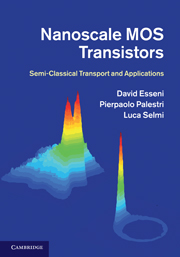Book contents
- Frontmatter
- Contents
- Preface
- Acknowledgements
- Terminology
- 1 Introduction
- 2 Bulk semiconductors and the semi-classical model
- 3 Quantum confined inversion layers
- 4 Carrier scattering in silicon MOS transistors
- 5 The Boltzmann transport equation
- 6 The Monte Carlo method for the Boltzmann transport equation
- 7 Simulation of bulk and SOI silicon MOSFETs
- 8 MOS transistors with arbitrary crystal orientation
- 9 MOS transistors with strained silicon channel
- 10 MOS transistors with alternative materials
- Appendices
- Index
5 - The Boltzmann transport equation
Published online by Cambridge University Press: 05 August 2011
- Frontmatter
- Contents
- Preface
- Acknowledgements
- Terminology
- 1 Introduction
- 2 Bulk semiconductors and the semi-classical model
- 3 Quantum confined inversion layers
- 4 Carrier scattering in silicon MOS transistors
- 5 The Boltzmann transport equation
- 6 The Monte Carlo method for the Boltzmann transport equation
- 7 Simulation of bulk and SOI silicon MOSFETs
- 8 MOS transistors with arbitrary crystal orientation
- 9 MOS transistors with strained silicon channel
- 10 MOS transistors with alternative materials
- Appendices
- Index
Summary
In this chapter we introduce the Boltzmann transport equation (BTE), which is the basis for the semi-classical description of carrier transport in electron devices. We begin with a brief reminder of the key assumptions behind the formulation of the BTE for a free carrier gas. Since this topic is extensively discussed in many textbooks [1, 2], we go on to focus on use of the BTE for the description of transport in inversion layers.
In particular, Section 5.4 explains how the carrier mobility in inversion layers can be computed solving the BTE in the Momentum Relaxation Time approximation, once the scattering rates introduced in Chapter 4 are known.
Section 5.5 reviews the methodology to solve the BTE in the limiting cases of near equilibrium transport through the derivation of balance equations and of the widely used Drift-Diffusion model.
At the end of the chapter, Section 5.6 overviews the modeling of the far from equilibrium ballistic transport and Section 5.7 illustrates the quasi-ballistic transport regime. Expressions for the MOSFET on-current are derived in all cases from Drift-Diffusion to purely ballistic transport. These equations become useful in Chapter 7 to interpret the results of numerical simulations.
The BTE for the free-carrier gas
As discussed in Section 2.5, the dynamics of electrons in crystals can be described in terms of classical point charges provided that the extension of the wave-packet in real and momentum space is assumed to be negligible.
- Type
- Chapter
- Information
- Nanoscale MOS TransistorsSemi-Classical Transport and Applications, pp. 207 - 267Publisher: Cambridge University PressPrint publication year: 2011



